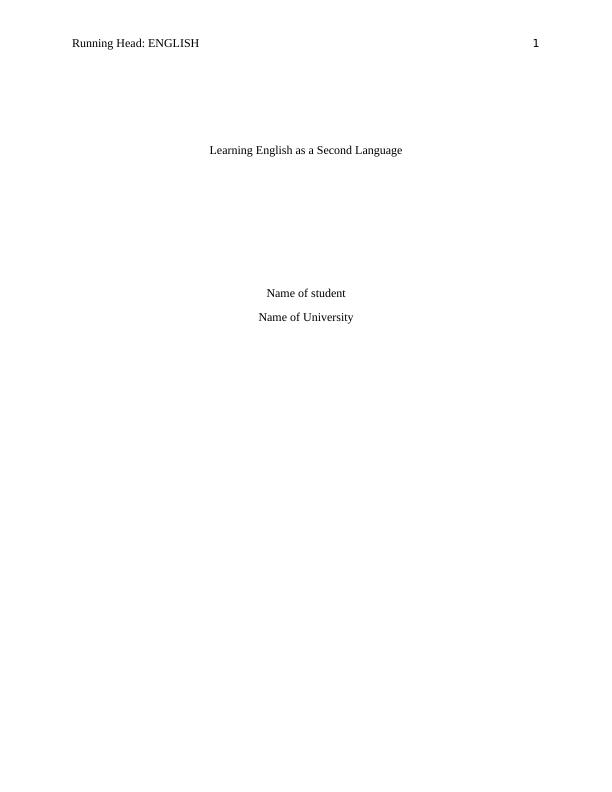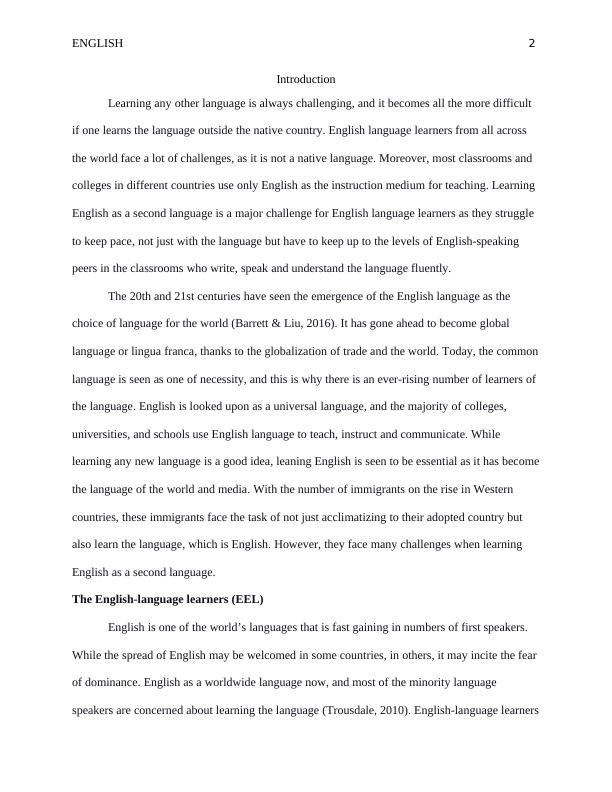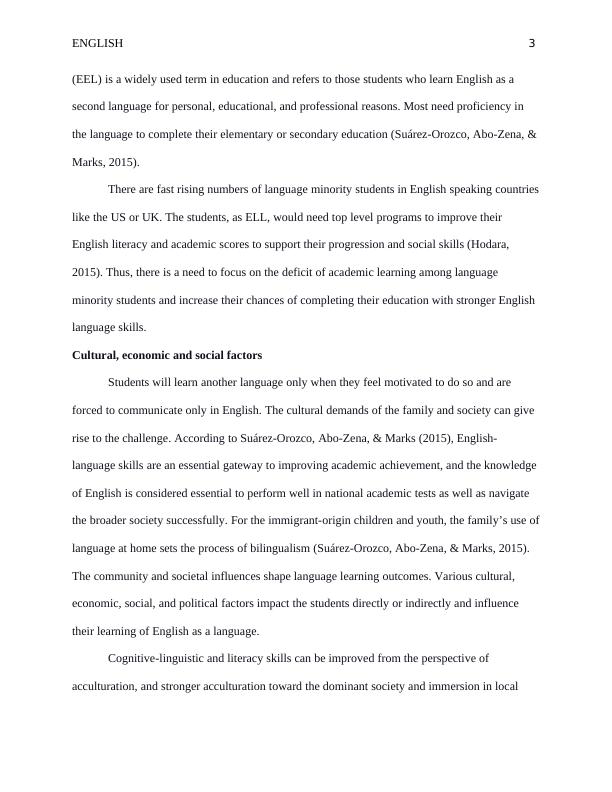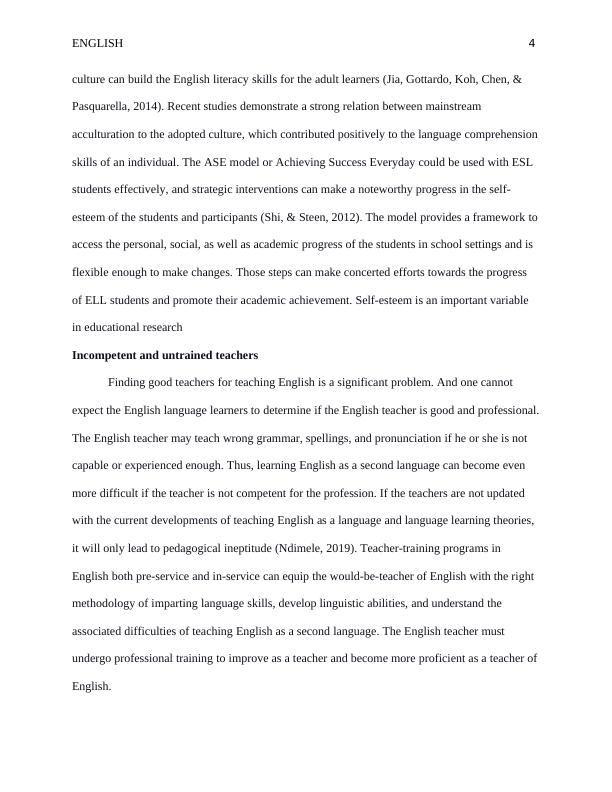Learning English as a Second Language Theory 2022
Added on 2022-09-25
11 Pages3081 Words23 Views
Running Head: ENGLISH 1
Learning English as a Second Language
Name of student
Name of University
Learning English as a Second Language
Name of student
Name of University

ENGLISH 2
Introduction
Learning any other language is always challenging, and it becomes all the more difficult
if one learns the language outside the native country. English language learners from all across
the world face a lot of challenges, as it is not a native language. Moreover, most classrooms and
colleges in different countries use only English as the instruction medium for teaching. Learning
English as a second language is a major challenge for English language learners as they struggle
to keep pace, not just with the language but have to keep up to the levels of English-speaking
peers in the classrooms who write, speak and understand the language fluently.
The 20th and 21st centuries have seen the emergence of the English language as the
choice of language for the world (Barrett & Liu, 2016). It has gone ahead to become global
language or lingua franca, thanks to the globalization of trade and the world. Today, the common
language is seen as one of necessity, and this is why there is an ever-rising number of learners of
the language. English is looked upon as a universal language, and the majority of colleges,
universities, and schools use English language to teach, instruct and communicate. While
learning any new language is a good idea, leaning English is seen to be essential as it has become
the language of the world and media. With the number of immigrants on the rise in Western
countries, these immigrants face the task of not just acclimatizing to their adopted country but
also learn the language, which is English. However, they face many challenges when learning
English as a second language.
The English-language learners (EEL)
English is one of the world’s languages that is fast gaining in numbers of first speakers.
While the spread of English may be welcomed in some countries, in others, it may incite the fear
of dominance. English as a worldwide language now, and most of the minority language
speakers are concerned about learning the language (Trousdale, 2010). English-language learners
Introduction
Learning any other language is always challenging, and it becomes all the more difficult
if one learns the language outside the native country. English language learners from all across
the world face a lot of challenges, as it is not a native language. Moreover, most classrooms and
colleges in different countries use only English as the instruction medium for teaching. Learning
English as a second language is a major challenge for English language learners as they struggle
to keep pace, not just with the language but have to keep up to the levels of English-speaking
peers in the classrooms who write, speak and understand the language fluently.
The 20th and 21st centuries have seen the emergence of the English language as the
choice of language for the world (Barrett & Liu, 2016). It has gone ahead to become global
language or lingua franca, thanks to the globalization of trade and the world. Today, the common
language is seen as one of necessity, and this is why there is an ever-rising number of learners of
the language. English is looked upon as a universal language, and the majority of colleges,
universities, and schools use English language to teach, instruct and communicate. While
learning any new language is a good idea, leaning English is seen to be essential as it has become
the language of the world and media. With the number of immigrants on the rise in Western
countries, these immigrants face the task of not just acclimatizing to their adopted country but
also learn the language, which is English. However, they face many challenges when learning
English as a second language.
The English-language learners (EEL)
English is one of the world’s languages that is fast gaining in numbers of first speakers.
While the spread of English may be welcomed in some countries, in others, it may incite the fear
of dominance. English as a worldwide language now, and most of the minority language
speakers are concerned about learning the language (Trousdale, 2010). English-language learners

ENGLISH 3
(EEL) is a widely used term in education and refers to those students who learn English as a
second language for personal, educational, and professional reasons. Most need proficiency in
the language to complete their elementary or secondary education (Suárez-Orozco, Abo-Zena, &
Marks, 2015).
There are fast rising numbers of language minority students in English speaking countries
like the US or UK. The students, as ELL, would need top level programs to improve their
English literacy and academic scores to support their progression and social skills (Hodara,
2015). Thus, there is a need to focus on the deficit of academic learning among language
minority students and increase their chances of completing their education with stronger English
language skills.
Cultural, economic and social factors
Students will learn another language only when they feel motivated to do so and are
forced to communicate only in English. The cultural demands of the family and society can give
rise to the challenge. According to Suárez-Orozco, Abo-Zena, & Marks (2015), English-
language skills are an essential gateway to improving academic achievement, and the knowledge
of English is considered essential to perform well in national academic tests as well as navigate
the broader society successfully. For the immigrant-origin children and youth, the family’s use of
language at home sets the process of bilingualism (Suárez-Orozco, Abo-Zena, & Marks, 2015).
The community and societal influences shape language learning outcomes. Various cultural,
economic, social, and political factors impact the students directly or indirectly and influence
their learning of English as a language.
Cognitive-linguistic and literacy skills can be improved from the perspective of
acculturation, and stronger acculturation toward the dominant society and immersion in local
(EEL) is a widely used term in education and refers to those students who learn English as a
second language for personal, educational, and professional reasons. Most need proficiency in
the language to complete their elementary or secondary education (Suárez-Orozco, Abo-Zena, &
Marks, 2015).
There are fast rising numbers of language minority students in English speaking countries
like the US or UK. The students, as ELL, would need top level programs to improve their
English literacy and academic scores to support their progression and social skills (Hodara,
2015). Thus, there is a need to focus on the deficit of academic learning among language
minority students and increase their chances of completing their education with stronger English
language skills.
Cultural, economic and social factors
Students will learn another language only when they feel motivated to do so and are
forced to communicate only in English. The cultural demands of the family and society can give
rise to the challenge. According to Suárez-Orozco, Abo-Zena, & Marks (2015), English-
language skills are an essential gateway to improving academic achievement, and the knowledge
of English is considered essential to perform well in national academic tests as well as navigate
the broader society successfully. For the immigrant-origin children and youth, the family’s use of
language at home sets the process of bilingualism (Suárez-Orozco, Abo-Zena, & Marks, 2015).
The community and societal influences shape language learning outcomes. Various cultural,
economic, social, and political factors impact the students directly or indirectly and influence
their learning of English as a language.
Cognitive-linguistic and literacy skills can be improved from the perspective of
acculturation, and stronger acculturation toward the dominant society and immersion in local

ENGLISH 4
culture can build the English literacy skills for the adult learners (Jia, Gottardo, Koh, Chen, &
Pasquarella, 2014). Recent studies demonstrate a strong relation between mainstream
acculturation to the adopted culture, which contributed positively to the language comprehension
skills of an individual. The ASE model or Achieving Success Everyday could be used with ESL
students effectively, and strategic interventions can make a noteworthy progress in the self-
esteem of the students and participants (Shi, & Steen, 2012). The model provides a framework to
access the personal, social, as well as academic progress of the students in school settings and is
flexible enough to make changes. Those steps can make concerted efforts towards the progress
of ELL students and promote their academic achievement. Self-esteem is an important variable
in educational research
Incompetent and untrained teachers
Finding good teachers for teaching English is a significant problem. And one cannot
expect the English language learners to determine if the English teacher is good and professional.
The English teacher may teach wrong grammar, spellings, and pronunciation if he or she is not
capable or experienced enough. Thus, learning English as a second language can become even
more difficult if the teacher is not competent for the profession. If the teachers are not updated
with the current developments of teaching English as a language and language learning theories,
it will only lead to pedagogical ineptitude (Ndimele, 2019). Teacher-training programs in
English both pre-service and in-service can equip the would-be-teacher of English with the right
methodology of imparting language skills, develop linguistic abilities, and understand the
associated difficulties of teaching English as a second language. The English teacher must
undergo professional training to improve as a teacher and become more proficient as a teacher of
English.
culture can build the English literacy skills for the adult learners (Jia, Gottardo, Koh, Chen, &
Pasquarella, 2014). Recent studies demonstrate a strong relation between mainstream
acculturation to the adopted culture, which contributed positively to the language comprehension
skills of an individual. The ASE model or Achieving Success Everyday could be used with ESL
students effectively, and strategic interventions can make a noteworthy progress in the self-
esteem of the students and participants (Shi, & Steen, 2012). The model provides a framework to
access the personal, social, as well as academic progress of the students in school settings and is
flexible enough to make changes. Those steps can make concerted efforts towards the progress
of ELL students and promote their academic achievement. Self-esteem is an important variable
in educational research
Incompetent and untrained teachers
Finding good teachers for teaching English is a significant problem. And one cannot
expect the English language learners to determine if the English teacher is good and professional.
The English teacher may teach wrong grammar, spellings, and pronunciation if he or she is not
capable or experienced enough. Thus, learning English as a second language can become even
more difficult if the teacher is not competent for the profession. If the teachers are not updated
with the current developments of teaching English as a language and language learning theories,
it will only lead to pedagogical ineptitude (Ndimele, 2019). Teacher-training programs in
English both pre-service and in-service can equip the would-be-teacher of English with the right
methodology of imparting language skills, develop linguistic abilities, and understand the
associated difficulties of teaching English as a second language. The English teacher must
undergo professional training to improve as a teacher and become more proficient as a teacher of
English.

End of preview
Want to access all the pages? Upload your documents or become a member.
Related Documents
Challenges Faced by English Language Learners and Teachers in ESL Classroomslg...
|14
|3546
|249
Best Practices of Teaching EELslg...
|5
|1044
|85
Importance of English as a Second Languagelg...
|8
|1844
|86
Education Teacher | Second Language Acquisitionlg...
|10
|2052
|21
Impact of bilingual education on student achievementlg...
|10
|5520
|404
ESP in the Legal Profession: Strategies for Needs Analysis and Teaching Reading and Listening Skillslg...
|19
|5022
|257
